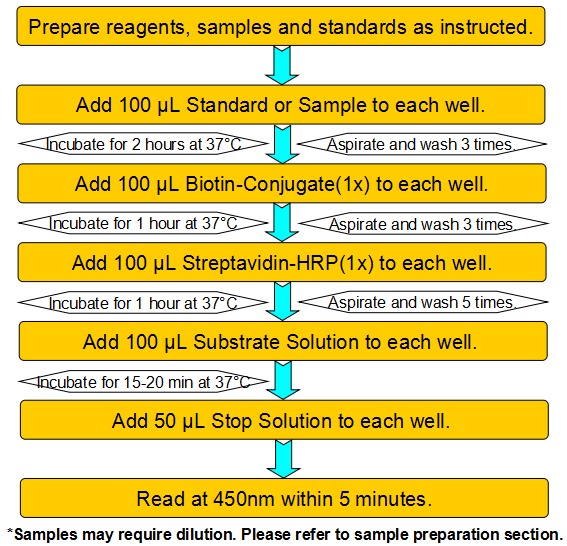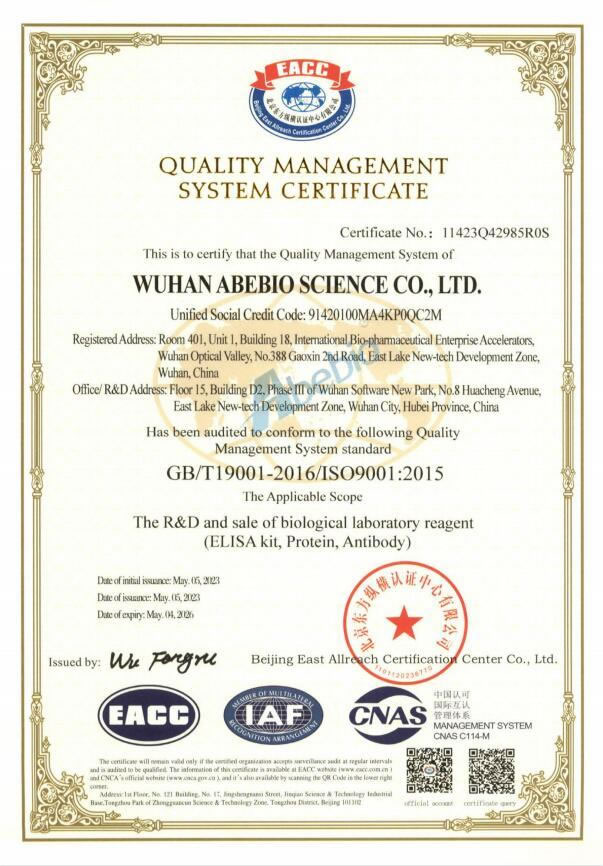Product Details
| Species Reactivity |
Human (Homo sapiens) |
| UniProt |
Q9H300 |
| Abbreviation |
PARL |
| Alternative Names |
PRO2207; PSARL; PSARL1; PSENIP2; RHBDS1; mitochondrial intramembrane-cleaving protease PARL|rhomboid 7 homolog 1 |
| Range |
31.25-2000 pg/mL |
| Sensitivity |
15.6 pg/mL |
| Sample Type |
Serum, Plasma, Other biological fluids |
| Detection Method |
Sandwich |
| Analysis Method |
Quantitive |
| Assay Duration |
1-4.5h |
| Sample Volume |
�1�-�2�0�0� μ�L |
| Detection Wavelengt |
450 nm |
Test principle
This assay employs a two-site sandwich ELISA to quantitate PARL in samples. An antibody specific for PARL has been pre-coated onto a microplate. Standards and samples are pipetted into the wells and any PARL present is bound by the immobilized antibody. After removing any unbound substances, a biotin-conjugated antibody specific for PARL is added to the wells. After washing, Streptavidin conjugated Horseradish Peroxidase (HRP) is added to the wells. Following a wash to remove any unbound avidin-enzyme reagent, a substrate solution is added to the wells and color develops in proportion to the amount of PARL bound in the initial step. The color development is stopped and the intensity of the color is measured.
Product Overview
PARL encodes a mitochondrial integral membrane protein. Following proteolytic processing of this protein, a small peptide (P-beta) is formed and translocated to the nucleus. This gene may be involved in signal transduction via regulated intramembrane proteolysis of membrane-tethered precursor proteins. Variation in this gene has been associated with increased risk for type 2 diabetes. Alternative splicing results in multiple transcript variants encoding different isoforms.The deduced 379-amino acid protein has a calculated molecular mass of about 42.2 kD. In vitro, PARL cDNA generated a polypeptide of about 40 kD. PARL shares significant similarity with the Drosophila development regulator Rhomboid, including 6 conserved transmembrane regions. In addition, PARL has a nonconserved N-terminal transmembrane helix.
Components
Reagents |
Quantity |
Reagents |
Quantity |
Assay plate (96 Wells) |
1 |
Instruction manual |
1 |
Standard (lyophilized) |
2 |
Sample Diluent |
1 x 20 mL |
Biotin-Conjugate (concentrate 100 x) |
1 x 120 μL |
Biotin-Conjugate Diluent |
1 x 12 mL |
Streptavidin-HRP (concentrate 100 x) |
1 x 120 μL |
Streptavidin-HRP Diluent |
1 x 12 mL |
Wash Buffer (concentrate 25 x) |
1 x 20 mL |
Substrate Solution |
1 x 10 mL |
Stop Solution |
1 x 6 mL |
Adhesive Films |
4 |
Specificity
This assay has high sensitivity and excellent specificity for detection of Human PARL. No significant cross-reactivity or interference between Human PARL and analogues was observed.
Recovery
Matrices listed below were spiked with certain level of recombinant Human PARL and the recovery rates were calculated by comparing the measured value to the expected amount of Human PARL in samples.
Precision
Intra-assay Precision (Precision within an assay)
Three samples of known concentration were tested twenty times on one plate to assess intra-assay precision.
Inter-assay Precision (Precision between assays)
Three samples of known concentration were tested in forty separate assays to assess inter-assay precision.
CV (%) = SD/meanX100
Intra-Assay: CV<8%
Inter-Assay: CV<12%
Linearity
The linearity of the kit was assayed by testing samples spiked with appropriate concentration of Human PARL and their serial dilutions. The results were demonstrated by the percentage of calculated concentration to the expected.
Stability
The stability of ELISA kit is determined by the loss rate of activity. The loss rate of this kit is less than 5% within the expiration date under appropriate storage condition.
The loss rate was determined by accelerated thermal degradation test. Keep the kit at 37°C for 4 and 7 days, and compare O.D.values of the kit kept at 37°C with that of at recommended temperature. (referring from China Biological Products Standard, which was calculated by the Arrhenius equation. For ELISA kit, 4 days storage at 37°C can be considered as 6 months at 2 - 8°C, which means 7 days at 37°C equaling 12 months at 2 - 8°C).
Sample collection and storage
�S�e�r�u�m�:� �U�s�e� �a� �s�e�r�u�m� �s�e�p�a�r�a�t�o�r� �t�u�b�e� �(�S�S�T�)� �a�n�d� �a�l�l�o�w� �s�a�m�p�l�e�s� �t�o� �c�l�o�t� �f�o�r� �t�w�o� �h�o�u�r�s� �a�t� �r�o�o�m� �t�e�m�p�e�r�a�t�u�r�e� �o�r� �o�v�e�r�n�i�g�h�t� �a�t� �2� �-� �8°�C� �b�e�f�o�r�e� �c�e�n�t�r�i�f�u�g�a�t�i�o�n� �f�o�r� �1�5� �m�i�n�u�t�e�s� �a�t� �1�0�0�0� ×� �g�.� �R�e�m�o�v�e� �s�e�r�u�m� �a�n�d� �a�s�s�a�y� �i�m�m�e�d�i�a�t�e�l�y� �o�r� �a�l�i�q�u�o�t� �a�n�d� �s�t�o�r�e� �s�a�m�p�l�e�s� �a�t� ≤� �-�2�0°�C�.� �A�v�o�i�d� �r�e�p�e�a�t�e�d� �f�r�e�e�z�e�-�t�h�a�w� �c�y�c�l�e�s�.�
�P�l�a�s�m�a�:� �C�o�l�l�e�c�t� �p�l�a�s�m�a� �u�s�i�n�g� �E�D�T�A�,� �o�r� �h�e�p�a�r�i�n� �a�s� �a�n� �a�n�t�i�c�o�a�g�u�l�a�n�t�.� �C�e�n�t�r�i�f�u�g�e� �f�o�r� �1�5� �m�i�n�u�t�e�s� �a�t� �1�0�0�0� ×� �g� �a�t� �2� �-� �8°�C� �w�i�t�h�i�n� �3�0� �m�i�n�u�t�e�s� �o�f� �c�o�l�l�e�c�t�i�o�n�.� �A�s�s�a�y� �i�m�m�e�d�i�a�t�e�l�y� �o�r� �a�l�i�q�u�o�t� �a�n�d� �s�t�o�r�e� �s�a�m�p�l�e�s� �a�t� ≤� �-�2�0°�C�.� �A�v�o�i�d� �r�e�p�e�a�t�e�d� �f�r�e�e�z�e�-�t�h�a�w� �c�y�c�l�e�s�.�
�O�t�h�e�r� �b�i�o�l�o�g�i�c�a�l� �f�l�u�i�d�s�:� �C�e�n�t�r�i�f�u�g�e� �s�a�m�p�l�e�s� �f�o�r� �2�0� �m�i�n�u�t�e�s� �a�t� �1�0�0�0� ×� �g�.� �R�e�m�o�v�e� �p�a�r�t�i�c�u�l�a�t�e�s� �a�n�d� �a�s�s�a�y� �i�m�m�e�d�i�a�t�e�l�y� �o�r� �s�t�o�r�e� �s�a�m�p�l�e�s� �i�n� �a�l�i�q�u�o�t� �a�t� �-�2�0°�C� �o�r� �-�8�0°�C�.� �A�v�o�i�d� �r�e�p�e�a�t�e�d� �f�r�e�e�z�e�/�t�h�a�w� �c�y�c�l�e�s�.
Kits storage instructions
Store at 2-8°C. Please refer to Instruction Manual.



